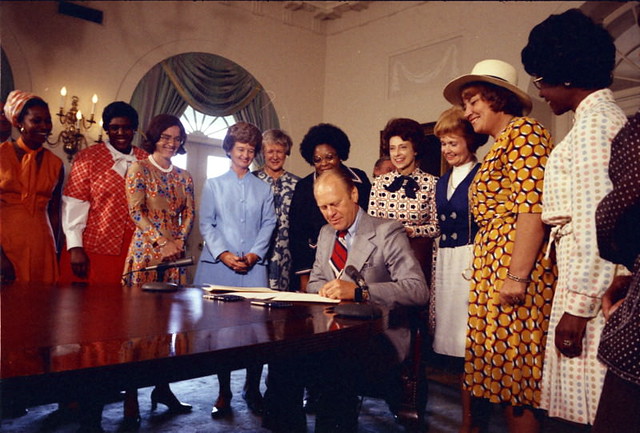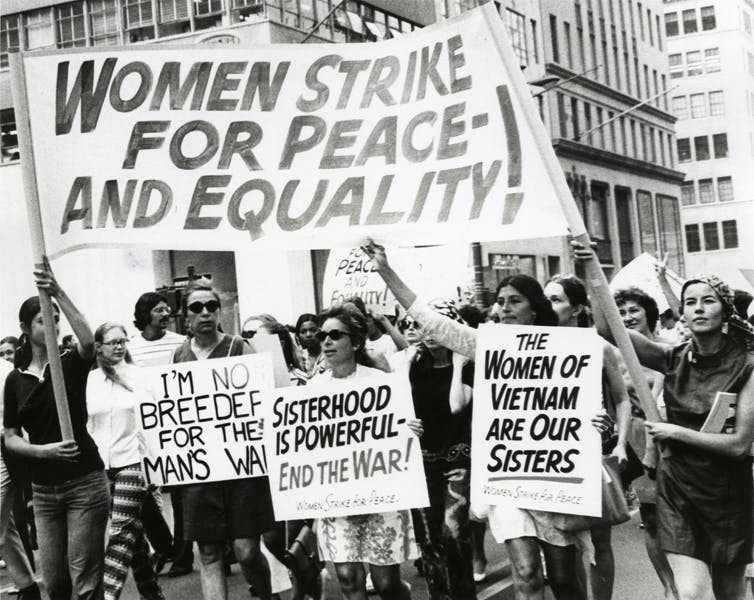Authors:
Historic Era: Era 10: Contemporary United States (1968 to the present)
Historic Theme:
Subject:
November/December 2024 | Volume 69, Issue 5


Authors:
Historic Era: Era 10: Contemporary United States (1968 to the present)
Historic Theme:
Subject:
November/December 2024 | Volume 69, Issue 5

Editor's Note: Elisabeth Griffith is the author of two acclaimed books on women's history, Formidable: American Women and the Fight for Equality: 1920–2020 and In Her Own Right: the Life of Elizabeth Cady Stanton. She has a PhD in history, and publishes a blog at Pink Threads on Substack.
On October 28, 1974, President Gerald Ford signed the Equal Credit Opportunity Act (ECOA). Until then, women could not get mortgages, business loans or credit cards in their own names. Without a male cosigner – husbands, fathers, brothers or friends, who were assumed to be more credit worthy, even if in jail – banks were unwilling to loan women money. The laws kept women financially dependent. Today anyone age eighteen or older can apply for a credit card or loan, based only on their credit history.
In 1974, sixteen women served in the House of Representatives (14D, 2R) and none in the Senate. There were three women on the Banking and Currency Committee (today the Committee on Financial Services): Margaret Heckler (R-MA), Lenore Sullivan (D-MO) and Corinne Boggs (D-LA). Sullivan was the senior member, Heckler wrote the draft law and Boggs, who had not yet served a full term, amended it.
The Equal Opportunity Credit Act was part of an amendment to the 1950 Federal Deposit Insurance Act. The EOCA outlawed discrimination against credit applicants on account of race, color, religion, national origin, sex, marital status, age or the use of public assistance. During mark up, the process of correcting text before printing, Boggs added “sex” and “marital status.”
Boggs was a seasoned politician but a new addition to the committee, having won a special election in March 1973. When the original draft failed to include protections for women, Boggs inserted the necessary words, took her version to the copier, and returned with the amended pages. As she handed them out, she observed, “Knowing the members of this Committee as well as I do, I’m sure it was just an oversight that we didn’t have ‘sex’ or ‘marital status’ included. I’ve taken care of that and I trust it meets with the Committee’s approval.” The committee unanimously endorsed her wording.
Representative Corinne (Lindy) Claiborne Boggs (D-LA) was the widow of House Majority Leader Hale Boggs, whose seat had been declared vacant after his plane went missing on a trip to Alaska. Coming from a family engaged in Louisiana politics for years, she was a skillful politician. As half of a DC power couple, the mother of three had managed her husband’s office and run his campaigns. In the 1974 general election, she would garner 80% of the vote in her New Orleans district.
Boggs would serve eighteen years. One colleague declared her “the only widow I know who is really qualified – damn qualified – to take over,” a compliment that insulted many capable Congresswomen. Boggs said her only reservation about running had been doing it “without a wife.” She believed “almost all women’s issues are economic issues. Women vote their pocketbooks.”
Even though Democrats controlled the House, in a more bipartisan era, Heckler was the bill’s lead sponsor. The EOCA was introduced in the House in October 1973 and passed in February 1974, by 282-94. The Senate passed an amended version in June by 89-0. Because of the Senate’s changes, the bill went to conference committee. Its version passed the House 355-1, the Senate approved it on a voice vote and President Ford signed it on October 28, 1974. Enforcement was the responsibility of the Federal Reserve Board. Passage of the 2010 Dodd-Frank Act transferred that authority to the Consumer Financial Protection Bureau.
Historically, across cultures and continents, women were considered the physical property of men. Common law, based on precedent rather than statutes in England and its colonies, derived from French feudalism. It divided females into femme sole, “woman alone,” or femme covert, literally a “covered [married] woman.” Coverture meant that women under the protection of men had no legal identity.

Femmes sole were unmarried, widowed, divorced or protected by a prenuptial agreement – and rare. Daughters were married off, women seldom survived to become widows, divorce was unacceptable and few women had any income to control. Married women, protected and controlled by husbands, shared the status of the infant, infirm, or insane.
Married women could not independently own or inherit property, keep wages, make wills, sign contracts, bring a lawsuit, divorce or have custody of children, who legally belonged to their fathers. Were an abused wife to escape her marriage, she could take only the clothes on her back. Husbands were responsible for their wives’ debts and had to provide their widows with a “dower right” or one-third of their estate. (Think the Dowager Duchess in the television program Bridgerton, who did not immediately retire to the Dower House, because her daughter-in-law, the new Duchess, needed her help, as did the Netflix series plot.)
Among the first challenges to coverture in the United States were married women’s property laws. At the 1848 Seneca Falls women’s rights convention, Elizabeth Cady Stanton railed against sundry “injuries and usurpations” by men, including making “married [women], in the eye of the law, legally dead . . . upon the false supposition of [male] supremacy.” Motivated by economic self-interest, wealthy fathers like hers did not want their assets squandered by untrustworthy sons-in-law. The conservative Judge Cady lobbied the Albany legislature to enact married